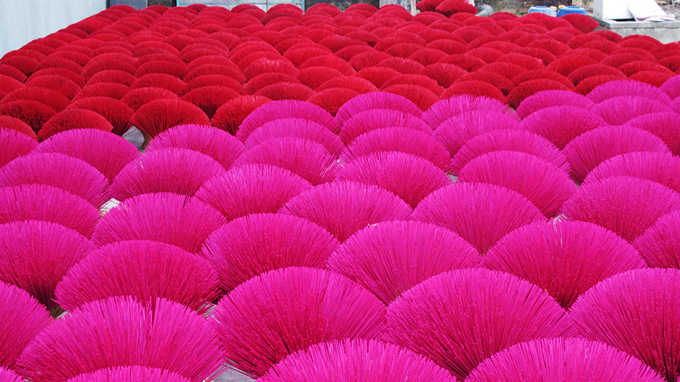Locals in famous Quang Phu Cau incense making village in Hanoi’s Ung Hoa district are working overtime to cater to surging demands for Tet, which begins on Jan 31.
A long time ago, locals of the village, some 35km from downtown Hanoi, would make incense only in the off-season, when they weren’t harvesting their fields. The seasonal job gradually turned into a fine craft, which is now the main source of income for 70% of the village’s 3,500 households.
Since a few weeks before Tet, the village, located at the intersection of National Highways 21B and 73, has been bursting with commotion and activity preparing for the year’s biggest season. Before, during, and after Tet, Vietnamese people make many offerings of incense to their ancestors, and many also go to pagodas and go on pilgrimages.
Locals work extra hours and machines run to their highest capacity to cater to surging demands for Tet. Trucks and bikes loaded with stock run back and forth all day. The village, seemingly covered with the red dye used for incense sticks, produces some 70 tons of incense each day.
According to Nguyen Thi Thuy, a veteran incense maker, as the market for round-stemmed incense sticks has increased in the past two years, villagers have switched to producing them exclusively instead of square-stemmed sticks. Round-stemmed sticks appeal more to consumers as they are made from combustible wood, which emits uninterrupted flame and heat.
The village’s incense sticks are not only a popular choice in Vietnam but also abroad. For exported stock, the locals usually use machinery to ensure that the sticks are equal in size and glossy.
Meanwhile, products sold domestically are manually made from “nua” (a kind of bamboo). The wood has to be steeped in water for two months to keep termites away before being split into incense sticks.
Ingredients for the sticks only cost around VND3,500 (US$0.2) a kg, while finished incense sticks fetch some VND10-25,000 a kg depending on their length and quality. The thriving and lucrative business has remarkably improved villagers’ living conditions and the village’s infrastructure.
Nguyen Thi Loan, who runs an incense stick workshop in the area, said she pockets some VND250-300 million ($14,151) in profits each year.
“It doesn’t take one long to learn the craft. Even kids and the elderly can do it. However, there is a high fire hazard, and dust from the dried wood can take a toll on workers’ health,” Loan noted.



















































